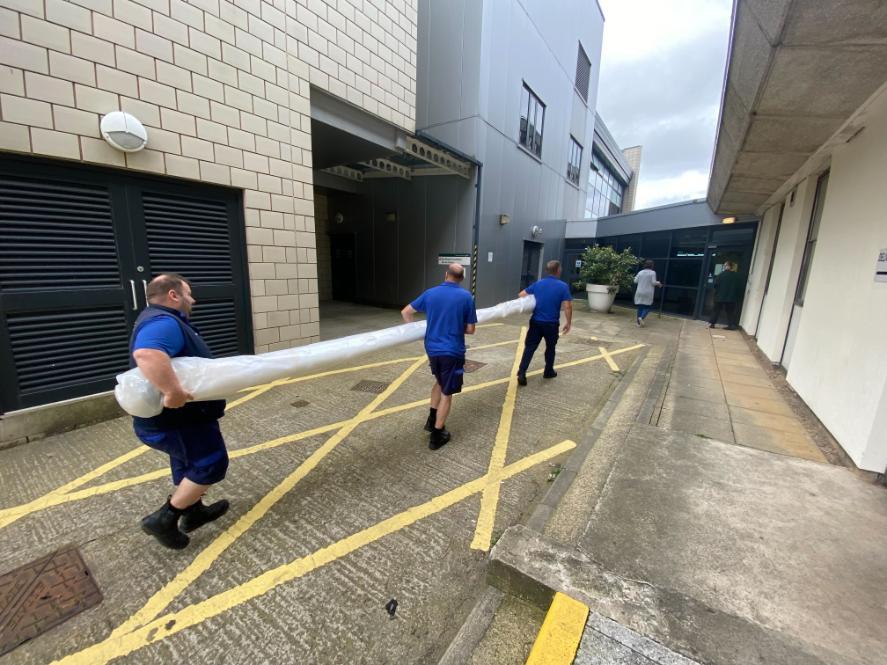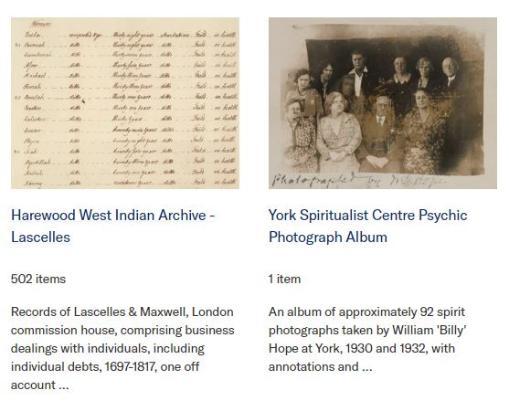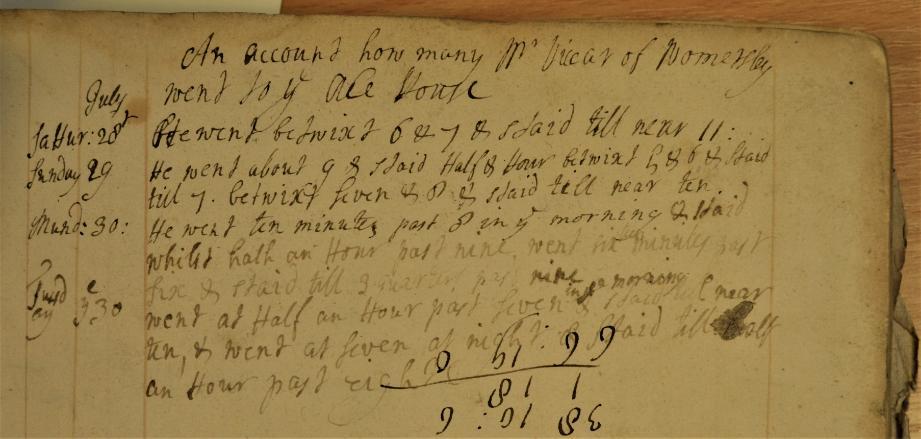Borthwick Newsletter - September 2023
Posted on 23 August 2023
September in the Archives - delve into our catalogues with this month’s featured description.
Court of Common Pleas, Hilary Term 1652/3. Writ of arrest to the sheriff in the case of William Thwinge against John Hill and Guy Abbey for the theft of 30 sheep at Monkgate on 27 September 1652. [Miscellaneous Documents MD/43]
What’s New
It’s been a rather damp and windy August in York but this hasn’t deterred visitors to the archive. As well as usual volunteers and researchers, we’ve welcomed two local groups who came to hear more about the archives, and shared a rare piece of film from our collections at the BFI Southbank in London. We’ve also been busy online. We mentioned last month that we had recently added digitised copies of the first four Visitation Court Books for the Archdeaconry of York to JSTOR, making them available to view, for free, anywhere in the world for the first time. Well, we’re pleased to say that we’ve continued to work on our JSTOR offerings in August and have now added a rare item from our York Spiritualist Centre Archive and hundreds of records from our Harewood West Indian Archive. You can read more about both in our cataloguing update below.
New Accessions
In August we added a new marriage register to our Westow parish archive, bringing the archive up to 2018. We also received three new boxes of material to add to our Marks and Gran Archive, the records of the award winning writers of television sitcoms such as Birds of a Feather, The New Statesman, and Goodnight Sweetheart, as well as the popular stage musical Dreamboats and Petticoats. The new addition includes scripts, correspondence, photographs and press cuttings relating to their work on stage and screen, as well as an unpublished novel and articles from their school and university days.

Accessions come in all shapes and sizes, however, and this month we took one of our largest single items yet - a plan of the City of York showing the York New Water Works Company Reservoir in the second half of the nineteenth century. The plan, which will be added to the York Waterworks Company Archive, is a whopping 4.7 metres long and needed three members of staff to manoeuvre it from the lorry, up the backstairs, through the strongroom and into our Lifelong Learning room - the only room with a long enough table to allow us to unroll it and assess its condition. It was quite a challenge to get it in the building at all and it won’t be leaving again in a hurry!
Cataloguing
Number of archival descriptions on Borthcat on 1st September 2023: 127,443
As well as adding new archives to our online catalogues, we like to enhance the existing catalogue information wherever possible - sometimes with indexes and sometimes with images of the records themselves. A small but fascinating enhancement we made in August was the digitisation of the album of ‘spirit’ photographs that came to us as part of the York Spiritualist Centre Archive. The photographs were taken by well known spirit photographer William ‘Billy’ Hope at York in 1930 and 1932 and show sitters from York and the local area and the spirit, or ‘psychic extra’ that appeared in the photograph with them. Each photo is labelled with the name and date and whether the sitter recognised the spirit. The origins of York Spiritualist Centre can be traced back to the Dawn of Day Spiritualist Circle founded in the city in 1899 and it remains active to this day.
In the case of the Harewood West Indian Archive we have been able to add both a list of contents and colour images of hundreds of the records over the past month. The Harewood archive is one of our most difficult and sensitive collections, comprising as it does the records of the Lascelles family which relate to their plantations in the Caribbean. The family amassed enormous wealth from the transatlantic slave trade, controlling some twenty four properties in the West Indies by the late eighteenth century, worked by thousands of enslaved Africans. Meanwhile, at home in Yorkshire, they served as Members of Parliament and were raised to the peerage as first Barons and then Earls of Harewood in 1796 and 1812 respectively. Although the archive has yet to be rearranged, you can now see a full box list online with detailed descriptions of individual files and items dating from 1677 through to 1825 or you can view the original documents for yourself through JSTOR. We are in the process of adding URLs to the online box list so that you will be able to seamlessly navigate between our catalogue and JSTOR in future. The archive includes many documents which record the names, and occasionally other details, of enslaved men, women and children, making it an enormously valuable survival and one which deserves to be shared more widely.
Borthwick Out and About
If you follow the Borthwick on social media you may have seen two of our archives being featured through the work of The Rowntree Society’s interns Sacha and Suzannah. Sacha used our Rowntree Family Papers to tell the story of keen birdwatcher Michael Rowntree on Twitter, featuring his 1934 photograph album which documented his trip to the Farne Islands at the age of 15. Michael later volunteered with the Friends Ambulance Unit in the Second World War and worked for Oxfam for many years. Over on Instagram Suzannah chronicled Jean Rowntree’s trip to America and Jamaica in the 1920s, where she and her sister Tony got to visit a Hollywood film set - and the Shredded Wheat Factory!
Onsite we’ve welcomed two groups of visitors. On the 17th August the York Cares Social Club joined us for a tour and a look through some highlights from the collection, followed by Selby & District Family History Society on the 22nd who heard an introductory talk from Access and Engagement Archivist Laura Yeoman on who we are, the collections we hold and how to access them, especially those that might be useful for family history research.
Finally, our Keeper of Archives Gary Brannan represented the Borthwick at the 35th anniversary of the classic TV archive Kaleidoscope who celebrated the milestone with an event at the BFI Southbank on the 5th August. ‘Missing Believed Wiped’ showcased the organisation’s work in recovering, restoring and helping to return lost British television programmes to the archives. Gary was there to discuss ‘Up The Toga’, the untransmitted 1972 US pilot version of Up Pompeii, starring Frankie Howerd, which was purchased by the Borthwick last December and restored by Kaleidoscope. However the event also featured the work of Laurence Marks and Maurice Gran who introduced the 1979 pilot of their sitcom Holding the Fort and discussed their long career in television. You can read more about the Frankie Howerd Archive and the Marks and Gran Archive on our online catalogue Borthcat.
Archive of the Month: Womersley Collection
What is it? The surviving estate and family papers of the Hawke family of Womersley Park, near Pontefract in Yorkshire.
Where can I find it? The complete catalogue is available on Borthcat.
Why is it Archive of the Month? Comprising only 12 boxes, the Womersley Collection is one of our smallest ‘estate’ archives, but what it lacks in size it makes up for in breadth, providing us with glimpses of the lives of those who worked the estate and the lives of its owners - as well as one or two mysteries! Womersley Park was built by Tobiah Harvey at the beginning of the eighteenth century, although his family had owned land in the area since the mid seventeenth century. It was Tobiah’s great granddaughter and sole heiress Frances who provided the link to the Hawkes by marrying, in 1798, Edward, 3rd Baron Hawke, who subsequently changed his name to Edward Harvey Hawke to preserve the Harvey name. The archive begins in the late seventeenth century and the first section traces, in broad terms, the development of the estate through to its sale in 1930, including estate surveys and the names of the many people who lived and worked there, from estate tenants, to farm labourers and house servants, along with how much they were paid. The second traces the lives of the Hawkes, in most cases through their financial accounts, telling us, for example, just what a wealthy gentleman might spend his money on during a trip to London in 1805, or the food, drink and other necessaries the lady of the house had to budget for in the late 19th century.
And speaking of financial accounts - the archive contains an intriguing mystery in the form of two volumes documenting the financial activities of an unknown London merchant in the late 1600s, or possibly two different merchants. One volume begins in 1679 and details the purchase of various haberdashery materials, including ‘shalloones’ (a fine serge wool fabric, often used for lining garments), linen, canvas and quantities of silk yarn. The second begins in 1682 and is a more neatly written ‘day book’ containing what the author, B.S. [possibly a Benjamin Scriven], describes as ‘all my Ways and Dealings in the way of Marchantaizing.’ What follows are regular inventories of stock and details of goods sold and received, with names of sellers and purchasers, covering 1682-1683. There are mentions of goods sent to Amsterdam, Lisbon, Genoa, Barbados and Jamaica (with the names of the ships and their commanders) and of dealings in Spanish tobacco, pepper, ginger, French wines, serge, silks and Holland cloth, and bales of paper. The identity of the merchant, or merchants, remains somewhat obscure, but what is clear is that by the eighteenth century both volumes were in possession of the Hawke family who used the back of each to record their own administration of the Womersley estate, including daily tasks assigned to estate workers, payments made, minor disputes and even the state of the weather. There is also, rather intriguingly, a small note of how many times ‘Mr Viccar of Womersley went to ye Ale House’ over the course of a week in July, with exact times provided, hinting at some long ago local drama. Small this archive might be, but boring it most certainly isn’t.
We’ll be back in October with more news from the archives!



